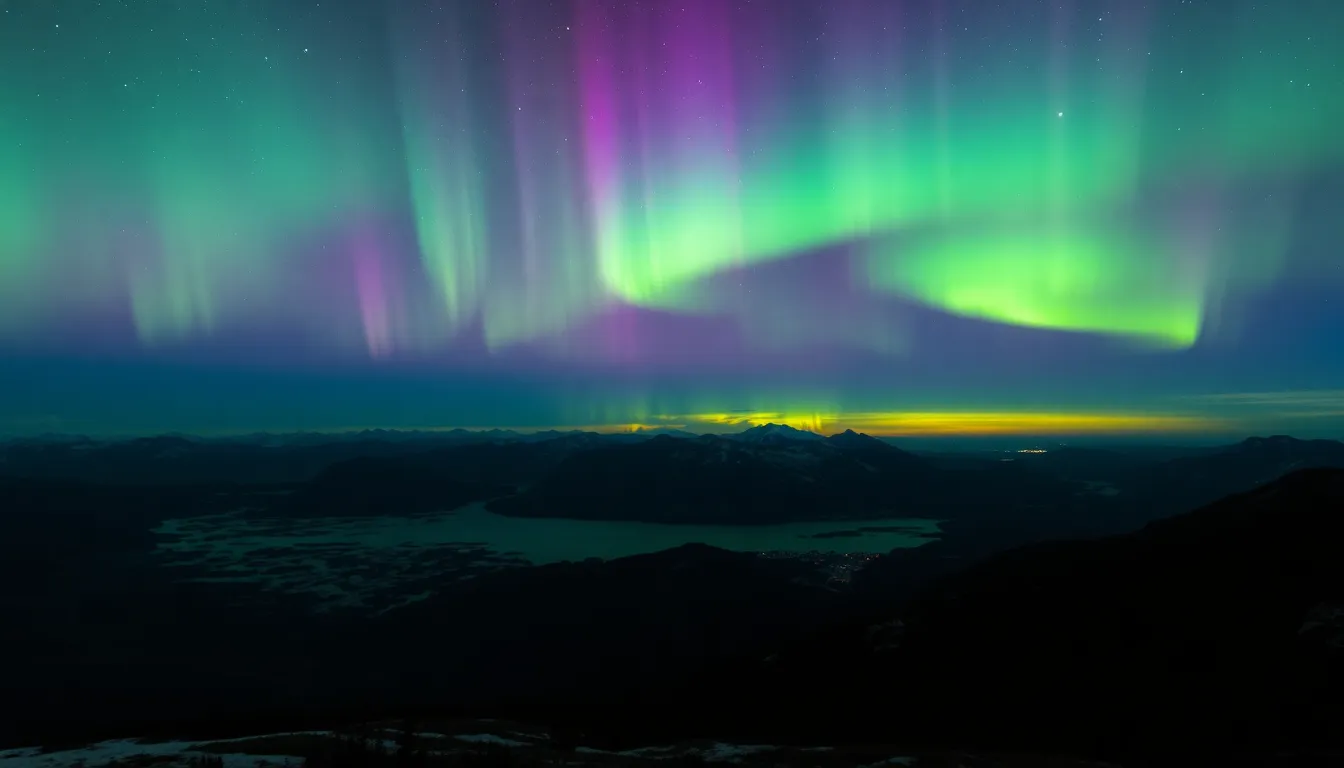The northern lights, or aurora borealis, captivate millions with their stunning displays of color dancing across the night sky. While traditionally associated with remote regions of the Arctic, these mesmerizing phenomena can also be seen in parts of the U.S., particularly during peak solar activity. As more people seek out this breathtaking experience, understanding the northern lights forecast becomes essential for those hoping to catch a glimpse.
This article delves into the latest forecasts for northern lights visibility in the U.S. By exploring factors influencing auroral activity and providing tips on the best viewing locations, readers will be better prepared to witness this natural wonder. Whether it’s a spontaneous road trip or a planned adventure, knowing when and where to look can make all the difference in experiencing this celestial spectacle.
Table of Contents
ToggleUnderstanding the Northern Lights
The northern lights, known as the aurora borealis, create a stunning natural display in the night sky, primarily observed in high-latitude regions. Understanding their characteristics and formation enhances the chance of witnessing this remarkable phenomenon.
What Are the Northern Lights?
The northern lights are vibrant displays of color in the sky, typically green, pink, or purple. These colors result from charged particles from the sun colliding with gases in Earth’s atmosphere. The intensity and variety of colors depend on factors like atmospheric conditions and the types of gases involved.
How Do They Occur?
Auroras occur due to interactions between solar wind and Earth’s magnetosphere. Solar wind, composed of charged particles released by the sun, travels toward Earth. When these particles reach the magnetosphere, they create disturbances. The collisions with atmospheric gases, primarily oxygen and nitrogen, produce light, resulting in the dazzling auroras seen in the night sky. Solar activity, particularly during solar flares or coronal mass ejections, significantly enhances auroral displays, making them more visible even at lower latitudes.
Northern Lights U.S. Forecast Overview

Northern lights forecasts play a crucial role in planning viewing experiences. Understanding these forecasts enables enthusiasts to maximize their chances of witnessing this breathtaking phenomenon.
Importance of Forecasting
Forecasts provide vital information on auroral activity levels. Accurate predictions help individuals decide when and where to search for the northern lights. Using data from sources such as the National Oceanic and Atmospheric Administration (NOAA) and the University of Alaska’s Geophysical Institute enhances these predictions. Decision-making improves as forecasts indicate potential visibility based on solar activity.
Factors Influencing the Forecast
Several factors influence northern lights forecasts:
- Solar Activity: Increased solar flares and coronal mass ejections directly correlate with auroral intensity.
- Geomagnetic Storms: The strength of geomagnetic storms determines how far south the auroras can be seen.
- Time of Year: Autumn and spring exhibit higher levels of auroral activity due to seasonal changes in the Earth’s magnetic field.
- Location: Regions close to the magnetic pole, such as Alaska and parts of the northern U.S., typically experience stronger displays.
Monitoring these factors helps enthusiasts stay informed and increases opportunities for witnessing northern lights firsthand.
Best Times to View the Northern Lights in the U.S.
Understanding when to view the northern lights enhances the experience. Specific times correlate with increased visibility based on seasonal patterns and optimal viewing conditions.
Seasonal Patterns
Winter months, particularly from December to March, present the best opportunities for viewing the northern lights in the U.S. Longer nights and clearer skies contribute to higher visibility during these months. Increased solar activity often coincides with winter, leading to more frequent auroras. During the equinoxes in March and September, heightened geomagnetic activity can also occur, making these periods ideal for aurora sightings, especially in Northern states such as Alaska, Minnesota, North Dakota, and Michigan.
Optimal Viewing Conditions
Clear, dark skies maximize the likelihood of witnessing the northern lights. Choosing locations away from city lights enhances visibility significantly. Ideal conditions include low humidity and minimal moonlight, as these factors reduce light pollution. Viewing during peak solar activity, often forecasted by NOAA and the Geophysical Institute, increases the chances of seeing vibrant displays. Additionally, staying outside for several hours and allowing eyes to adjust to the darkness further improves viewing experiences.
Top Locations for Northern Lights Viewing in the U.S.
Certain locations in the U.S. offer excellent opportunities for witnessing the northern lights. The following destinations are recognized for optimal aurora visibility.
Alaska
Alaska ranks as the premier location for viewing the northern lights in the U.S. Fairbanks stands out due to its location under the auroral oval, providing an average of 200 nights of aurora visibility each year. Popular spots in Fairbanks include Creamer’s Field and the Chena Lake Recreation Area. The interior region, characterized by clear, dark skies, often experiences minimal light pollution, enhancing visibility.
Northern Minnesota
Northern Minnesota features several renowned spots for northern lights viewing. The Boundary Waters Canoe Area Wilderness offers vast, uninhabited expanses with complete darkness, making it an ideal area. Additionally, Voyageurs National Park provides scenic landscapes and limited light interference. Popular viewing locations within these parks include Lake Kabetogama and Rainy Lake, both known for vibrant auroras.
Other Notable Locations
Several other states present opportunities to see the northern lights. Areas in the Upper Peninsula of Michigan, especially around Marquette, boast clear skies for nocturnal viewing. Additionally, New York’s Adirondack Mountains and Maine’s Aroostook County also serve as excellent viewing sites. The latter’s remote landscape ensures minimal light pollution, increasing the chances of spectacular auroral displays.
Experiencing the northern lights in the U.S. is a magical adventure that many dream of. With the right knowledge and preparation, anyone can increase their chances of witnessing this breathtaking display. Staying informed about forecasts and understanding the best times and locations to view the auroras can make all the difference.
Whether it’s the stunning vistas of Alaska or the serene landscapes of the Midwest, the northern lights offer an unforgettable experience. As solar activity peaks and conditions align, the night sky transforms into a canvas of vibrant colors. Embracing the journey to see this natural wonder will surely leave lasting memories.



